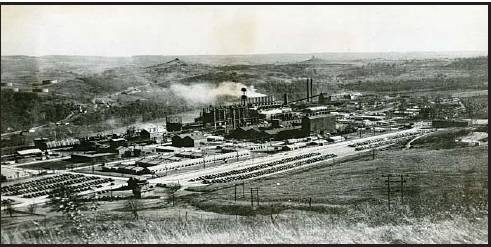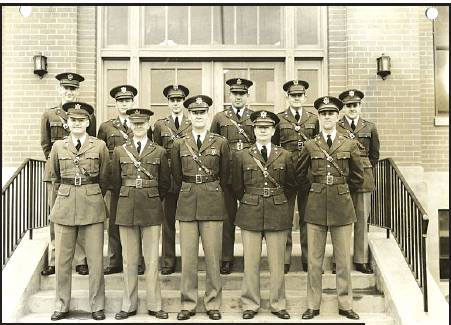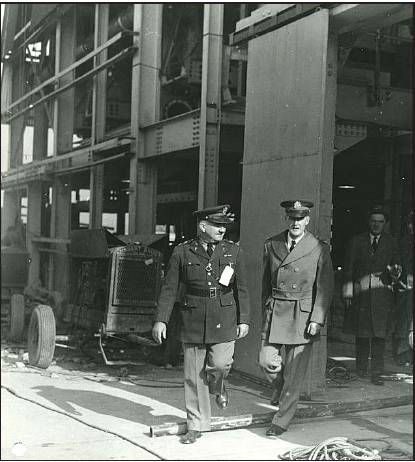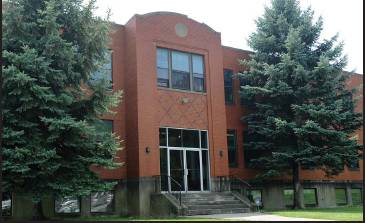Industry’s History: Industrial Park’s First Site Built in ’40s
Morgantown Dominion Post
22 August 2011
By Tracy Eddy
The first plant at the Morgantown Industrial Park site — off River Road
— was built in less than a year. Ground was broken December
1940.

A few houses surround Dupont Chemical plant
(left). The river is located on the far side of the plant. Automobiles can be seen in the parking lots. [Note: The plant received coal by river barge, as well
as shipments on the Monongahela Railroad.] - Photo courtesy of W.Va.
Regional History Collection, WVU Libraries
By November 1941, 825 acres of farmland near the Monongahela River had
become the Morgantown Ordnance Works — a plant to produce ammonia for
army ammunition.

The staff of the Morgantown Ordnance Works
(top)
stands in front of the building in this undated photo. The
building
behind them now houses Enrout's administrative offices (below). - Photo
courtesy of W.Va. Regional History Collection, WVU Libraries
Today, the Morgantown Industrial Park is home to more than 20
businesses — plants and offices, as well as two Marcellus shale wells.
Chemtura, Dominion Hope, Central Supply and a WVU laundry facility are
among the businesses at the park. Also, The Make-A-Wish Foundation has
office space there.

Maj. Gen. C. T. Harris Jr. (left), of the
Ordnance Department, and Lt. Col. John Huling seen outside Morgantown
Ordnance Works. - Photo courtesy of W.Va.
Regional History Collection, WVU Libraries
The park is privately owned and is in an unincorporated part of
Monongalia County.
Kevin Adrian — who coowns the park and Enrout Properties with his
brother, Glenn Adrian, and William Bland — said the Morgantown
Industrial Park is a work in progress.
The majority of the businesses working from the park were already
there, he said, but there was some neglect as well. Older, unused
facilities were run down, roads needed repaving and the park needed to
be restructured to allow for expansion.
That work is being done now — some of it with Tax Increment Financing
(TIF).
History of the park
According to “The Monongalia Story” by Earl L. Core, construction
of the Morgantown Ordnance Works cost more than $37 million in 1940.
The original plant had 13 major structures and a score of smaller units.
At the peak of its operations, the plant had more than 1,400 employees.
About 18,700 tons of ammonia were produced monthly. Alcohol, hexamine
(which can be used as an antibiotic) and formaldehyde were also
produced there.
Operations were suspended Aug. 20, 1945.
According to “The Monongalia Story,” the Morgantown Community
Association paid the U.S. General Services Administration $1.25 million
for 600 acres of the property. Morgantown Ordnance Works, Inc. — which
was owned by J.W. Ruby — took over the property and turned it into an
industrial park.
Enrout Properties LLC owns 450 acres of the original industrial park,
Adrian said. Local developer Dave Biafora owns 50 acres near the
entrance of the Morgantown Industrial Park.
There are three ways to access the park — the rail system, the
Monongahela River and the road. Adrian said all three are still used.
Don Reinke, executive director of the Monongalia County Development
Authority, said the Morgantown Industrial Park is the largest
industrial park in the county. There aren’t many in Mon, he said,
because of the topography — industrial parks require large, flat tracts
of developable land.
Other business or light industrial parks in the county include the
Chaplin Hill Business Park, Chaplin Hill Road; the Fort Martin
Industrial Park, Maidsville; the Morgantown Research and Office Park,
near the Morgantown Municipal Airport; and the 90-acre park proposed
near the airport.
Today’s park
Flexible — that’s one way to describe today’s industrial park,
Adrian said. The park is privately owned. Space there is open to any
business — including offices, light manufacturing plants and warehouses
— as long as they’re federally and state permitted, he said.
Businesses can lease or buy space in the park, Adrian said. Most that
buy space construct their own facilities, he said, but will often ask
that the site be “pad ready” — meaning excavation and other prep work
is done.

The Morgantown Industrial Park in Westover
(above)
as seen from the top of the park. Some of the original buildings in the
park are being razed. - Jason DeProspero/The Dominion Post
If businesses choose to lease the space, Enrout will work with them to
develop appropriate facilities.
Very few of the original facilities are left at the park, Adrian said —
the red brick building where Enrout’s offices are located is one.
The company is tearing down some of the old structures to make way for
any possible new facilities, he said. Roads are being resurfaced and a
new road — Rail Street — is being built to open up more of the park for
development.
The Monongalia County Commission approved a TIF for the Morgantown
Industrial Park in 2008.
TIF uses the projected increase in property tax revenue
created by developing the area to assist in paying for development
and/or redevelopment projects, according to the West Virginia
Development Office.
The project plan initially indicated TIF money — up to $14,175,000 —
would be used for basic infrastructure, such as roadways, sidewalks and
utilities. The County Commission recently approved an amendment to the
plan, allowing the TIF money to be used to raze old buildings, as well.
Adrian said no TIF money has been used for demolition yet.

Enrout's administrative offices today - Jason DeProspero/The Dominion Post




